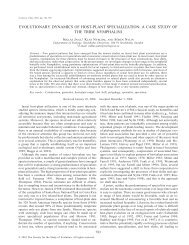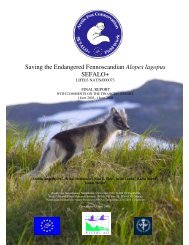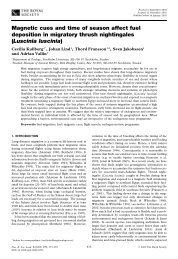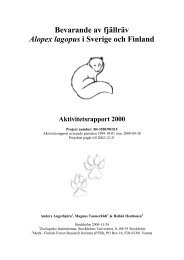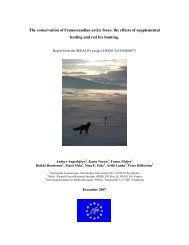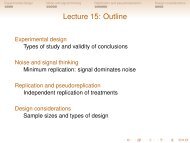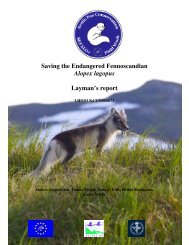A difference in pupal morphology between the sibling species ...
A difference in pupal morphology between the sibling species ...
A difference in pupal morphology between the sibling species ...
You also want an ePaper? Increase the reach of your titles
YUMPU automatically turns print PDFs into web optimized ePapers that Google loves.
Nota lepid. 30 (1): 61–6461A <strong>difference</strong> <strong>in</strong> <strong>pupal</strong> <strong>morphology</strong> <strong>between</strong> <strong>the</strong> sibl<strong>in</strong>g <strong>species</strong>Leptidea s<strong>in</strong>apis and L. reali (Pieridae)MAGNE FRIBERGDepartment of Zoology, Stockholm University, SE-10691, Stockholm, Sweden;e-mail: magne.friberg@zoologi.su.seAbstract. The sister <strong>species</strong> Leptidea s<strong>in</strong>apis and L. reali are virtually identical and <strong>species</strong> identificationhas so far only been possible through DNA-sequenc<strong>in</strong>g or genital preparation. Here, I show an <strong>in</strong>terspecific<strong>difference</strong> <strong>in</strong> <strong>pupal</strong> <strong>morphology</strong>. The <strong>pupal</strong> antennae of L. s<strong>in</strong>apis are white with a well-def<strong>in</strong>ed longitud<strong>in</strong>alp<strong>in</strong>k l<strong>in</strong>e <strong>in</strong> <strong>the</strong> middle, while those of L. reali are predom<strong>in</strong>antly p<strong>in</strong>k with only scattered whitepigments close to <strong>the</strong> marg<strong>in</strong> on both sides.IntroductionIn 1988, it was discovered that <strong>the</strong> formerly well-known and well-studied butterfly<strong>species</strong> Leptidea s<strong>in</strong>apis actually consisted of two separate <strong>species</strong>: L. s<strong>in</strong>apis and L.reali (wood white/ Real’s wood white) (Réal 1988; Reiss<strong>in</strong>ger 1989; Lorcovic´ 1993).The two <strong>species</strong> are morphologically virtually identical, and have so far only beendist<strong>in</strong>guishable us<strong>in</strong>g ei<strong>the</strong>r genital preparation (Lorcovic´ 1993; Mazel 2005), DNAsequenc<strong>in</strong>g (Mart<strong>in</strong> et al. 2003, Friberg et al. 2007), or male mat<strong>in</strong>g behaviour (Friberget al. unpubl. ms). Both <strong>species</strong> are present <strong>in</strong> most parts of Europe, and although <strong>the</strong>yappear to be partially partitioned <strong>in</strong> habitat <strong>in</strong> most parts of <strong>the</strong>ir distribution <strong>the</strong>y arestill often found syntopically and synchronically at <strong>the</strong> same sites (Beneš et al. 2003;Vila et al. 2003; Amiet 2004; Friberg et al. 2007). The <strong>species</strong> are reproductively isolated,and <strong>the</strong> isolation is implemented by <strong>the</strong> females’ ability to dist<strong>in</strong>guish <strong>between</strong>con- and heterospecific males; males court both con- and heterospecific females, whilefemales only accept to mate with conspecifics both <strong>in</strong> <strong>the</strong> field (Friberg et al. unpubl.ms.) and <strong>in</strong> <strong>the</strong> laboratory (Freese & Fiedler 2002; Friberg et al. unpubl. ms.).So far most studies of <strong>the</strong> sister <strong>species</strong> L. s<strong>in</strong>apis and L. reali (see Mart<strong>in</strong> et al. 2003)have concerned ei<strong>the</strong>r <strong>the</strong>ir distribution (Mazel 2002; Beneš et al. 2003; Mazel andEitschberger 2003; Vila et al. 2003; Amiet 2004), <strong>the</strong>ir habitat partition<strong>in</strong>g (Beneš etal. 2003; Vila et al. 2003; Amiet 2004; Friberg et al. 2007) or <strong>the</strong>ir sexual behaviour(Freese and Fiedler 2002; Friberg et al. unpubl. ms.). Only a few studies have fur<strong>the</strong>ranalyzed potential morphological <strong>difference</strong>s, and <strong>the</strong>n only adult <strong>difference</strong>s and primarilygenital <strong>difference</strong>s <strong>between</strong> <strong>the</strong> <strong>species</strong> (Lorkovic’ 1993; Mazel 2005). No studieshave so far dealt with potential <strong>species</strong>-specific morphological <strong>difference</strong>s <strong>in</strong> o<strong>the</strong>rdevelopmental stages.Here, I show an <strong>in</strong>terspecific <strong>difference</strong> <strong>between</strong> L. s<strong>in</strong>apis and L. reali that allowsaccurate <strong>species</strong> recognition based on <strong>pupal</strong> <strong>morphology</strong>. The two <strong>species</strong> differ <strong>in</strong> colorationof <strong>the</strong> <strong>pupal</strong> antennae, with L. s<strong>in</strong>apis hav<strong>in</strong>g a more dist<strong>in</strong>ct edge <strong>between</strong> <strong>the</strong><strong>in</strong>ner p<strong>in</strong>k stripe and <strong>the</strong> surround<strong>in</strong>g white pigmentation than L. reali.Nota lepidopterologica, 15.05.2007, ISSN 0342-7536
Nota lepid. 30 (1): 61–6463aFig. 2a. The ventral side of a L. reali pupa at 10 × magnification. The arrow <strong>in</strong>dicates <strong>the</strong> <strong>pupal</strong> antennaethat are closed up at 40 × magnification <strong>in</strong> figure 2b, where arrow 1 <strong>in</strong>dicates <strong>the</strong> undef<strong>in</strong>ed central p<strong>in</strong>kl<strong>in</strong>e that runs along <strong>the</strong> length of <strong>the</strong> antenna and arrow 2 <strong>in</strong>dicates <strong>the</strong> pale p<strong>in</strong>k area that surrounds <strong>the</strong>central l<strong>in</strong>e.bbecome more pigmented due to <strong>the</strong> ongo<strong>in</strong>g metamorphosis. L. s<strong>in</strong>apis pupae that areclose to eclosion are <strong>the</strong>refore difficult to dist<strong>in</strong>guish from those of L. reali.So far most research effort concern<strong>in</strong>g <strong>the</strong> biology of L. s<strong>in</strong>apis and L. reali has focusedon <strong>the</strong> adult stage. This study of <strong>pupal</strong> <strong>morphology</strong> resulted <strong>in</strong> <strong>the</strong> f<strong>in</strong>d<strong>in</strong>g of a characterthat makes accurate <strong>species</strong> determ<strong>in</strong>ation possible, which highlights <strong>the</strong> importance ofstudy<strong>in</strong>g all life stages when search<strong>in</strong>g for <strong>species</strong>-specific characters.AcknowledgementsI am grateful to Christer Wiklund, Niklas Wahlberg, and one anonymous reviewer for read<strong>in</strong>g and comment<strong>in</strong>gon an earlier draft of this manuscript.ReferencesAmiet, J. L. 2004. Ecological niche partition<strong>in</strong>g <strong>between</strong> two sympatric sibl<strong>in</strong>g Leptidea <strong>species</strong> (Lepidoptera,Pieridae). – Revue D Ecologie-la Terre et la Vie 59: 433–452.Beneš, J., M. Konvicka, V. Vrabec & J. Zámečník 2003. Do <strong>the</strong> sibl<strong>in</strong>g <strong>species</strong> of small whites, Leptideas<strong>in</strong>apis and L. reali (Lepidoptera, Pieridae) differ <strong>in</strong> habitat preferences? – Biologia Bratislava58: 943–951.Freese, A. & K. Fiedler 2002. Experimental evidence for <strong>species</strong> dist<strong>in</strong>ctness of <strong>the</strong> two wood white butterflytaxa, Leptidea s<strong>in</strong>apis and L. reali (Pieridae). – Nota lepidopterologica 25: 39–59.Friberg, M., M. Bergman, J. Kullberg, N. Wahlberg & C. Wiklund 2007. Niche separation <strong>in</strong> space andtime <strong>between</strong> two sympatric sister <strong>species</strong> – a case of ecological pleiotropy. – Evolutionary Ecology,DOI 10.1007/s10682-007-9155-yLorkovic´, Z. 1993. Leptidea reali Reiss<strong>in</strong>ger 1989 (=lorkovicii Real, 1988), a new European <strong>species</strong> (Lepid.,Pieridae). – Natura Croatia 2: 1–26.Mart<strong>in</strong>, J-F., A. Gilles & H. Descimon 2003. Species concepts and sibl<strong>in</strong>g <strong>species</strong>: The case of Leptideas<strong>in</strong>apis and Leptidea reali. Pp. 459–476. – In: C. L. Boggs, W. B. Watt & P. R. Ehrlich (eds.), Butterflies– Ecology and evolution tak<strong>in</strong>g flight. – University of Chicago Press, Chicago.Mazel, R. 2002. Répartition géographique de Leptidea s<strong>in</strong>apis (L., 1758) et L. reali Reiss<strong>in</strong>ger, 1989au nord de l’Europe, en Russie et dans quelqes pays d’Asie (Lepidoptera: Pieridae, Dismorphi<strong>in</strong>ae).– L<strong>in</strong>neana Belgica 18: 373–376.
64 FRIBERG: Pupal <strong>difference</strong> <strong>between</strong> Leptidea s<strong>in</strong>apis and L. realiMazel, R. 2005. Éléments de phylogénie dans le genre Leptidea Bilberg 1820 (Lepidoptera, Pieridae,Dismorphi<strong>in</strong>ae). – Revue de l’Association roussillonaise d’Entomologie 14: 98–111.Mazel, R. & U. Eitschberger 2003. Biogéographie de Leptidea reali Reiss<strong>in</strong>ger, 1989 en Europe et enTurquie / Die Verbreitung von Leptidea reali Reiss<strong>in</strong>ger, 1989 <strong>in</strong> Europa und <strong>in</strong> der Türkei. – Revuede l’Association roussillonaise d’Entomologie 12: 91–109.Réal, P. 1988. Lepidoptères noveaux pr<strong>in</strong>cipalement Jurassiens. – Mémoires de Comité de Liaison pour lesRecherches Ecofaunistiques dans le Jura. Publication apériodique, Besançon: 17–24.Reiss<strong>in</strong>ger, E. 1989. Checkliste Pieride Duponchel, 1835 der Westpalaearctis (Europa, Nordwestafrika,Kaukasus, Kle<strong>in</strong>asien). – Atalanta 20: 149–185.Vila, R., S. Viader & J. Jubany 2003. Leptidea s<strong>in</strong>apis (L<strong>in</strong>naeus, 1758) i L. reali (Reiss<strong>in</strong>ger 1988): duesecpécies ”bessones” a Catalunya i Andorra (Lepidoptera: Pieridae). – Buttleti Societat Catalana Lepidopterologia90: 25–47.



